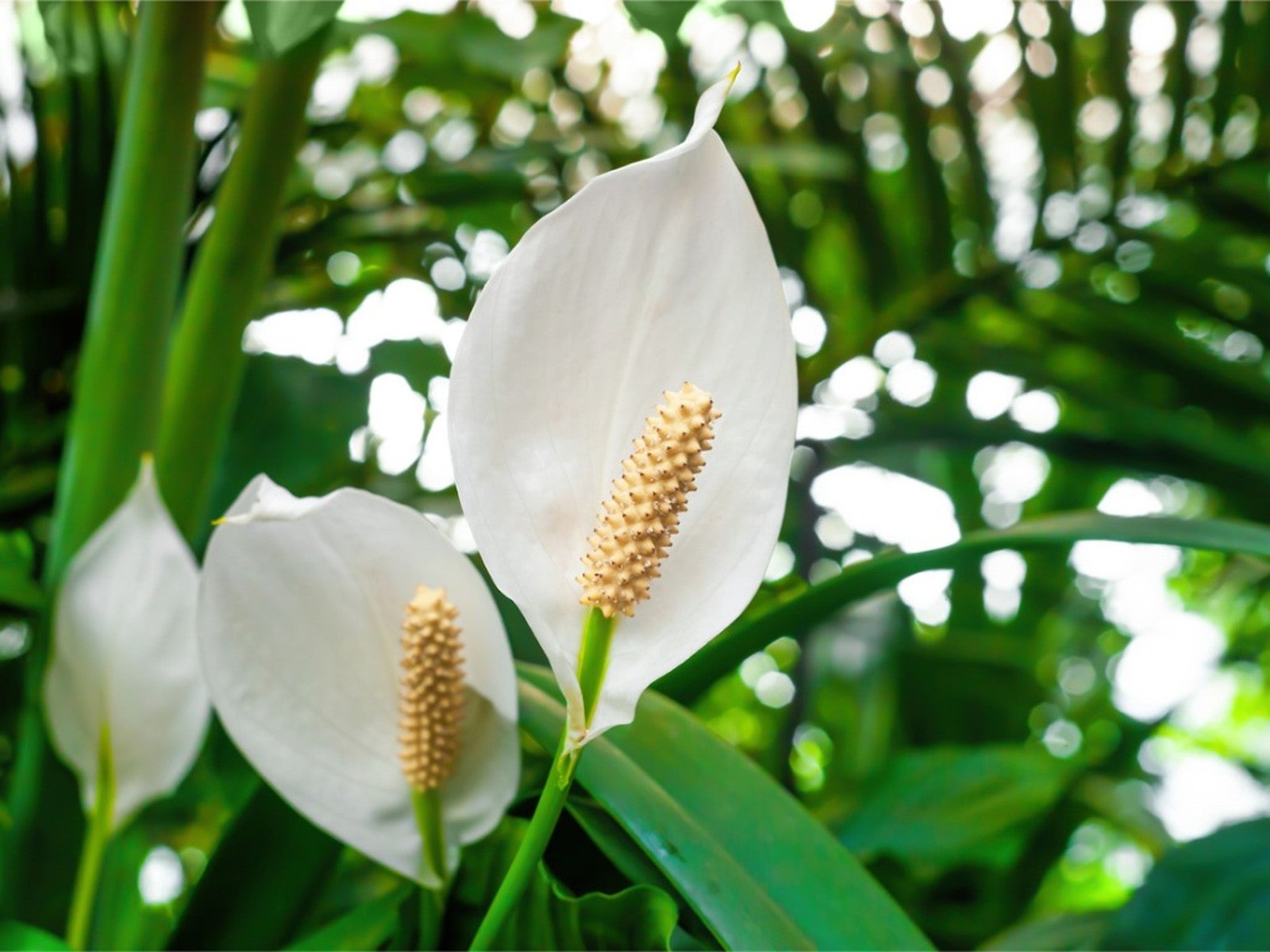Care Of Peace Lilies As Houseplants

Mary Ellen Ellis

Peace lily (Spathiphyllum) is a group of tropical plants native to Central and South America. In the U.S. they are mostly used as indoor houseplants, but can be grown outdoors in summer with the right conditions. “Peace lily” describes about 50 species within the Spathiphyllum genus. In their native tropical range, they grow in clumps on the floor of the forest.
Quick Facts about Peace Lilies
- Botanical name - Spathiphyllum
- Height - 1 to 6 feet (0.3 to 1.8 m)
- Spread - 1 to 5 feet (0.3 to 1.5 m)
- Sun exposure - Partial to deep shade
- Soil requirements - Rich potting soil
- Hardiness zones - 11 and 12
- When to plant - Year round indoors
Peace lilies are lovely houseplants for the home or office, and are said to be excellent at cleaning the air in a room. Most commonly these plants have dark green leaves and white “flowers.” However, what most people think of as the flower is actually a specialized leaf bract that grows hooded over the flowers.
How to Grow a Peace Lily
Peace lily care is easy, making this a great houseplant for beginners. Here are some tips for how to care for a peace lily indoors.
Peace Lily Light Requirements
In their native habitat, peace lilies are adapted to dappled light and can even tolerate deep shade. As a houseplant, bright, filtered light works best for an indoor peace lily. These plants should never be placed in direct light, which can cause leaf scorching.
However, peace lilies placed in brighter light tend to produce the lovely white spathes and flowers more frequently. Peace lilies bloom less when grown in low light, and should be treated as be more of a traditional foliage plant.
Watering Peace Lily Plants
Peace lilies grow best in soil that’s moist but not soggy. They should never be overwatered or allowed to sit in water, which can cause root rot. Good soil drainage is very important for this plant.
Allow the soil to dry before watering a peace lily. It will tolerate some degree of neglect in terms of watering and still recover. However, our experts suggest that peace lily plants should not be watered on a schedule, but rather checked once a week to see if they truly need it. Simply touch the top of the soil to see if it is dry. If it’s still damp, wait a bit.
Sign up for the Gardening Know How newsletter today and receive a free copy of our e-book "How to Grow Delicious Tomatoes".
Some houseplant parents like to wait until their peace lily is starting to droop before watering the plant. Since these plants are fairly drought tolerant, this method does not harm the plant and may help you avoid overwatering.
Peace Lily Repotting Tips
Your peace lily will not need to be repotted often. In fact, it does best when it’s root bound, which is another characteristic that makes it a good houseplant. Repot a peace lily when its roots start showing through the drainage holes or are visible above the soil around the base of the plant.
Signs that the plant needs a larger home are if it droops less than a week after being watered, or if the leaves become crowded or deformed. The best times to repot are in late winter or early spring. When repotting, move the peace lily plant into a container that is at least 2 inches (5 cm) larger than its current pot.
How to Propagate Peace Lilies
You can propagate a peace lily by division. Remove the entire plant from the pot and remove one or more crowns for replanting. Try to gently pull the crowns apart or use a sharp knife if they don't separate easily. You can also simply use a sharp knife to cut through the center of the rootball and replant each half in its own container.
Soil & Fertilizer for Peace Lily Plants
Plant Spathiphyllum in a container with a good quality well-draining potting mix. Feed your peace lily with a general houseplant fertilizer every six to eight weeks during the growing season. Use it at only a quarter of the recommended strength. Peace lilies are very sensitive to overfertilization, which can cause burning on their leaf tips and edges.
Problems, Pests & Diseases
Pests and diseases of peace lilies are not common. Soggy conditions can cause root rot. Possible pest infestations include mealybugs and scale.
The large, flat leaves of peace lilies get dusty and should be wiped regularly. This will help the plant to process sunlight better. This is also a good opportunity to check for signs of pests. Avoid commercial leaf shine products which can clog the pores of the plant. Washing the plant can be done by either setting it in the bath and giving it a short shower or by placing it in a sink and letting the tap gently run over the leaves.
Peace Lily Varieties
As a popular houseplant, its easy to find a few different species and cultivars of peace lily at your local garden center or online:
Spatiphyllum wallisii
This is one of the most common species of peace lily grown as a houseplant. There are several varieties within the species. It has the classic peace lily look of glossy, lance-shaped leaves and showy flowers with white spathes.
"Sensation"
This is the largest commercially cultivated peace lily. It grows up to six feet (1.8 m) tall and wide. The leaves are dark green and strongly textured.
"Mauna Loa Supreme"
A medium variety, this peace lily grows to about two or three feet (0.6 to 0.9 m) tall. The white flowers are large.
"Allison"
Allison is a smaller variety, topping out at about two feet (0.6 m). It flowers profusely.
"Jetty"
This cultivar is also about two feet (0.6 m) tall and wide. It has very glossy leaves and long-lasting flowers.
"Little Angel"
For a truly compact peace lily, try "Little Angel." It grows to about 12 inches (30 cm) and blooms prolifically.
"Jet Diamond"
This newer cultivar might be a little more difficult to find, but it's worth a search. It has dark green leaves with silvery variegation.
Check out our Complete Guide to Houseplants for more houseplant ideas.

Heather Rhoades founded Gardening Know How in 2007. She holds degrees from Cleveland State University and Northern Kentucky University. She is an avid gardener with a passion for community, and is a recipient of the Master Gardeners of Ohio Lifetime Achievement Award.
- Mary Ellen EllisWriter